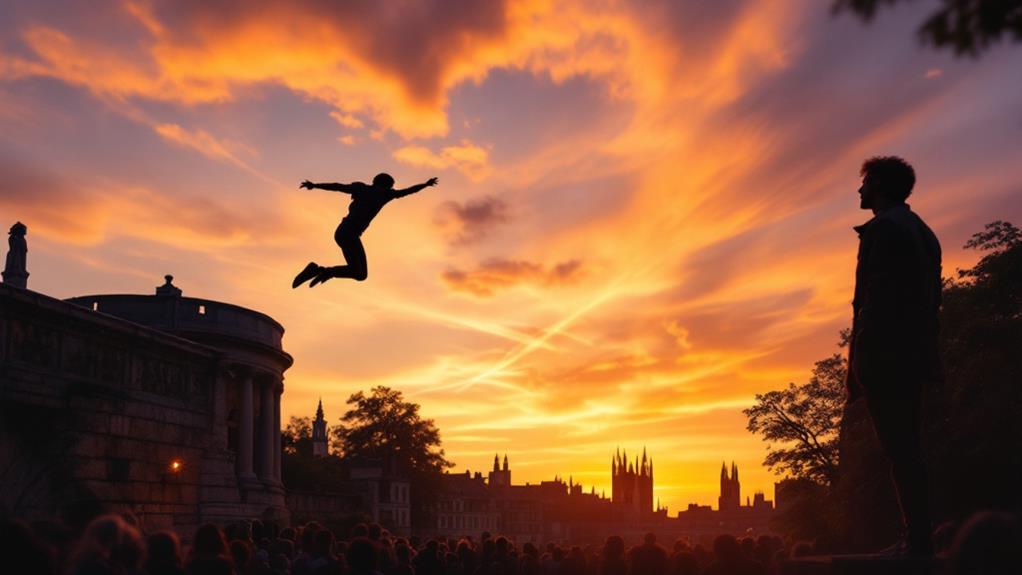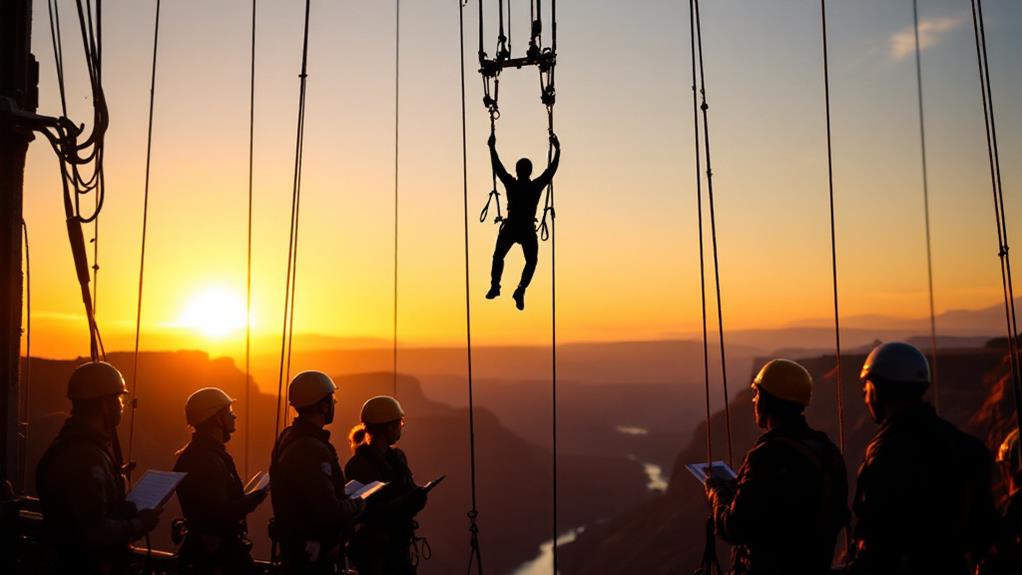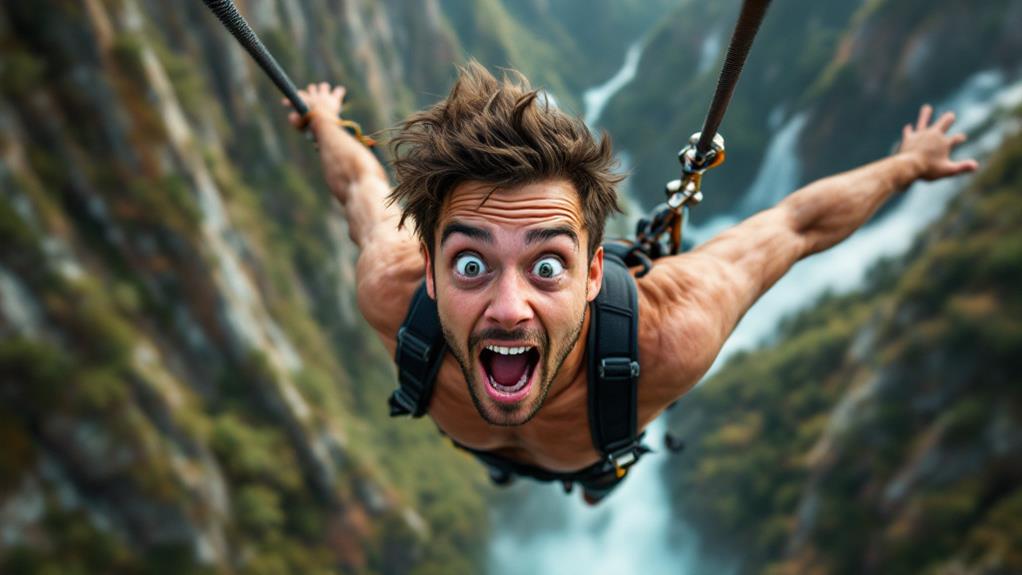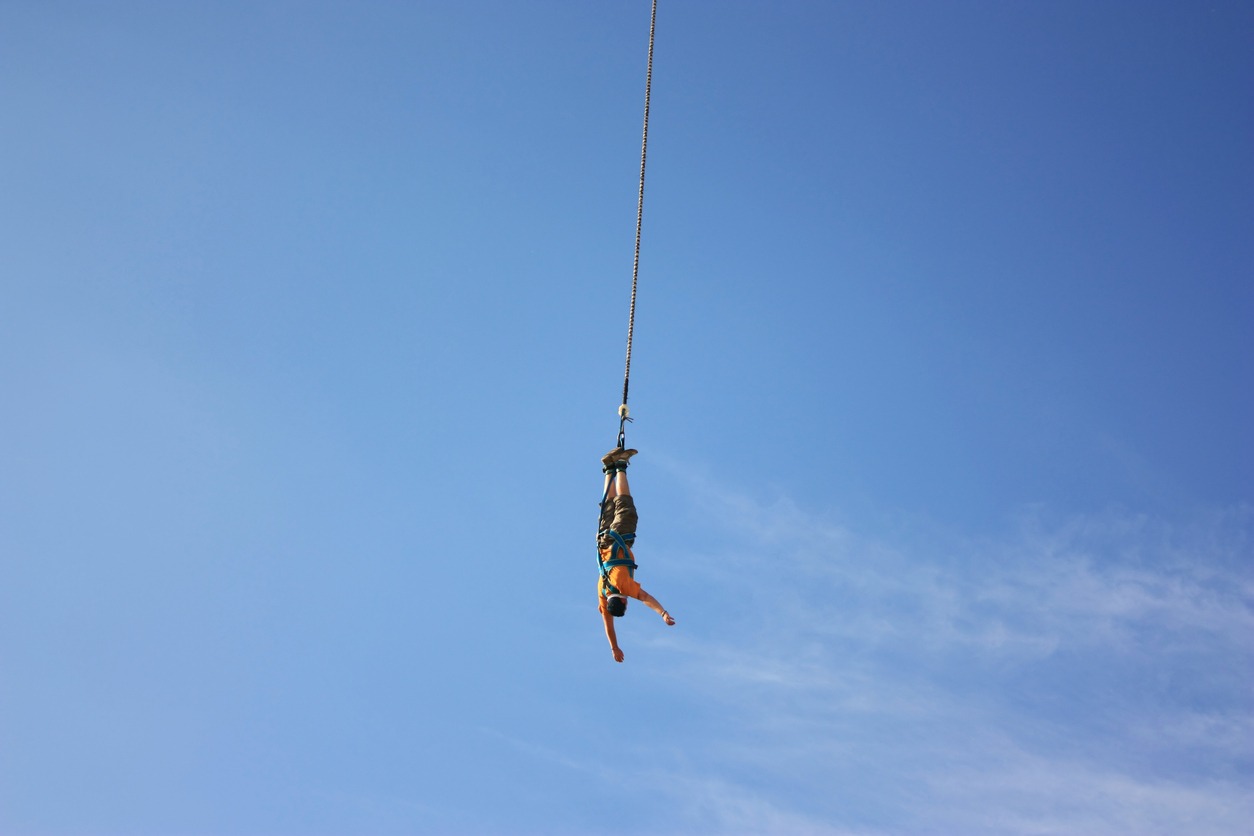History of Bungee Jumping

Bungee jumping's roots trace back to the ancient land diving ritual on Pentecost Island, Vanuatu. This centuries-old practice caught Western attention in the 20th century, inspiring the modern sport. In 1979, members of Oxford University's Dangerous Sports Club made the first modern bungee jump from Bristol's Clifton Suspension Bridge. The activity quickly gained popularity, leading to commercial operations and global spread. Safety innovations and regulations have since evolved, making the sport more accessible. You'll find bungee jumping featured in movies, TV shows, and as a symbol of courage in popular culture. There's much more to uncover about this thrilling adventure sport's journey through time.
Ancient Origins in Vanuatu
Many people are surprised to learn that bungee jumping's roots trace back to the South Pacific island nation of Vanuatu. On Pentecost Island, a centuries-old ritual called land diving has been practiced as a rite of passage and a way to ensure a bountiful yam harvest. This ancient custom caught the attention of Western visitors in the 20th century, ultimately inspiring the modern sport of bungee jumping. The first commercial bungee jump took place in 1979, drawing directly from Vanuatu's land diving tradition.
The story behind land diving involves a woman fleeing her abusive husband. She climbed a tree and tied vines to her ankles before jumping. Her husband followed, but without vines, resulting in his death. Men began practicing land diving to avoid being tricked by women in the future.
From Ritual to Recreation
The thrill-seekers of the Western world soon caught wind of Vanuatu's land diving tradition, sparking a global interest in this daring act. In the 1970s, members of the Oxford University Dangerous Sports Club began experimenting with elastic ropes for jumping. They made their first modern bungee jump from Bristol's Clifton Suspension Bridge in 1979, causing a media sensation and attracting police attention.
This event marked the transition of bungee jumping from a sacred ritual to a recreational activity. Throughout the 1980s, you'd see the sport gaining popularity in New Zealand, where entrepreneur A.J. Hackett commercialized it. He famously jumped from the Eiffel Tower in 1987, further propelling bungee jumping into the global spotlight. Crocodile bungee jumping is an extreme sport that has gained attention, with fans in Australia and the possibility of encountering crocodiles in the water below.
As safety measures improved, bungee jumping sites started popping up worldwide. You could now experience the adrenaline rush from bridges, cranes, and specially designed platforms. The sport's appeal lies in its ability to offer a controlled brush with danger, allowing you to face your fears and push your limits in a relatively safe environment.
The Oxford University Bridge Jump

While bungee jumping was gaining global attention, its modern incarnation can be traced back to a single, daring event. On April 1, 1979, members of the Oxford University Dangerous Sports Club made history at the Clifton Suspension Bridge in Bristol, England. You'll be amazed to learn that these thrill-seekers, led by David Kirke, jumped from the 250-foot-high bridge using elastic ropes.
The jump wasn't just a spur-of-the-moment decision. They'd carefully planned and prepared for this audacious feat. Here's a breakdown of the key elements:
| Aspect | Details | Significance |
|---|---|---|
| Equipment | Elastic ropes, harnesses | Pioneered modern bungee gear |
| Location | Clifton Suspension Bridge | Iconic site, perfect height |
| Participants | Oxford Dangerous Sports Club | Daring students pushing limits |
This event caught the media's attention and sparked worldwide interest in bungee jumping. You can trace the birth of commercial bungee operations directly to this jump. It's fascinating to think that a group of students' bold idea would evolve into a global adventure sport, inspiring millions to take the plunge and experience the ultimate adrenaline rush.
Commercialization and Global Spread
Following the Oxford University Bridge Jump, bungee jumping's popularity skyrocketed, paving the way for its commercialization. In 1988, A.J. Hackett opened the world's first commercial bungee jumping site in New Zealand. This marked the beginning of a global phenomenon, as thrill-seekers worldwide sought out the adrenaline rush of free-falling.
You'll find that bungee jumping quickly spread to other countries, with operators setting up sites at bridges, cranes, and purpose-built towers. The sport's growth led to the development of safety standards and regulations to ensure jumpers' well-being. As technology advanced, operators introduced variations like tandem jumps and water touches to enhance the experience.
The commercialization of bungee jumping has had a significant impact:
- Boosted adventure tourism in many regions
- Created new job opportunities in the extreme sports industry
- Inspired the development of other adrenaline-pumping activities
- Contributed to local economies through increased visitor numbers
- Sparked debates about risk-taking and personal responsibility
Today, you can experience bungee jumping at hundreds of locations worldwide, from urban centers to remote natural wonders. The sport continues to evolve, with enthusiasts constantly pushing the boundaries of height, style, and innovation.
Safety Innovations and Regulations

Recognizing the inherent risks of bungee jumping, industry professionals and regulators have worked tirelessly to enhance safety measures and establish comprehensive guidelines. You'll find that modern bungee operations now use advanced equipment and follow strict protocols to minimize accidents.
One of the most significant innovations is the development of specialized bungee cords. These cords are engineered to provide optimal elasticity and durability, reducing the risk of breakage or excessive stretching. You'll also notice redundant attachment systems, ensuring that if one connection fails, backup measures are in place.
Harnesses have evolved too, with designs that distribute force more evenly across your body and provide better support. You'll be fitted with a harness that's appropriate for your weight and body type.
Regulations now mandate regular equipment inspections, staff training, and detailed record-keeping. You'll often see height and weight restrictions enforced, and many operators require health screenings before you can jump.
Despite these advancements, it's crucial to remember that bungee jumping still carries risks. Always choose reputable operators and follow all safety instructions to ensure your jump is as safe as possible.
Notable Bungee Jumping Locations
Dozens of breathtaking bungee jumping locations have emerged worldwide, offering thrill-seekers unique and unforgettable experiences. You'll find iconic spots like the Bloukrans Bridge in South Africa, the world's highest commercial bungee jump at 216 meters. New Zealand's Kawarau Bridge, where commercial bungee jumping began, remains a popular destination for enthusiasts.
If you're looking for a truly extraordinary jump, head to the Verzasca Dam in Switzerland, featured in the James Bond film "GoldenEye." For a tropical experience, try the Skypark by AJ Hackett in Macau, offering stunning views of the city skyline. In the United States, you can't miss the Royal Gorge Bridge in Colorado, suspended 321 meters above the Arkansas River.
These locations offer more than just an adrenaline rush:
- Spectacular natural scenery
- Cultural experiences in diverse destinations
- Opportunities to challenge personal fears
- Unique photographic moments
- A sense of accomplishment and empowerment
When planning your bungee jumping adventure, consider factors like height, surrounding landscape, and local regulations. Many locations offer package deals, including photos and videos of your jump. Remember to check the operator's safety record and certifications before taking the plunge.
Record-Breaking Jumps

Audacity fuels the pursuit of record-breaking bungee jumps. You'll find thrill-seekers constantly pushing the limits of this extreme sport. In 2008, Mike Heard set the record for most bungee jumps in 24 hours, completing 103 jumps from Auckland's Harbour Bridge. He later broke his own record in 2017 with 430 jumps in one day.
The highest commercial bungee jump is at the Macau Tower in China, standing at 764 feet. However, the record for the highest bungee jump ever goes to James Packer, who jumped from a helicopter hovering 1,000 feet above Switzerland's Verzasca Dam in 2018.
For the longest bungee jump, you'll need to travel to Nepal. In 2018, a 764-foot jump was completed from the Bhote Koshi River bridge. The record for the longest urban bungee jump belongs to the 764-foot leap from Macau Tower.
These records continue to inspire bungee enthusiasts worldwide. As technology and safety measures improve, you can expect to see even more impressive feats in the future, pushing the boundaries of what's possible in bungee jumping.
Cultural Impact and Media Representation
Bungee jumping's thrilling nature has catapulted it into popular culture, leaving an indelible mark on media and entertainment. You'll find it featured in countless movies, TV shows, and commercials, often used to symbolize courage, risk-taking, and adventure. From James Bond's daring leap in "GoldenEye" to bungee-inspired challenges in reality shows like "The Amazing Race," the sport has become a cinematic shorthand for extreme thrills.
In the world of advertising, bungee jumping's visual impact has made it a go-to for brands looking to convey excitement and push boundaries. You've likely seen it used to sell everything from energy drinks to insurance policies. The sport has also inspired video games, with virtual bungee jumping experiences allowing players to feel the rush without the real-world risk.
Here's why bungee jumping resonates so strongly in media:
- It's visually spectacular
- It represents conquering fear
- It symbolizes freedom and rebellion
- It offers a universal adrenaline rush
- It creates instant drama and tension
Psychological Aspects of Bungee Jumping

The adrenaline-fueled thrill of bungee jumping isn't just about the physical experience; it's a psychological rollercoaster that pushes your mental limits. As you stand on the edge, your body's fight-or-flight response kicks in, flooding your system with cortisol and adrenaline. You'll feel your heart racing and palms sweating as your mind grapples with the perceived danger.
Overcoming this intense fear is a significant psychological challenge. You're battling against your survival instincts, which are screaming at you not to jump. This internal struggle can lead to a profound sense of achievement once you take the plunge, boosting your self-confidence and resilience.
The experience can also alter your perception of time. As you fall, you might experience a sense of timelessness or heightened awareness, known as "flow state." This can lead to feelings of euphoria and a shift in your perspective on life and death.
For some, bungee jumping can be a form of exposure therapy, helping to overcome fears of heights or falling. However, it's crucial to recognize that the intense emotions involved can also trigger anxiety or panic attacks in susceptible individuals.
Future Trends and Developments
Looking ahead, bungee jumping is poised for exciting innovations and growth. You'll see advancements in safety technology, with new harness designs and more sophisticated elastic cords. Virtual reality integration will allow you to experience simulated jumps before taking the real plunge, enhancing preparation and reducing anxiety.
Eco-friendly materials and sustainable practices will become more prevalent in the industry. You'll find bungee jumping locations expanding to urban settings, with purpose-built towers offering unique cityscapes. Extreme variations of the sport will emerge, combining bungee jumping with other adrenaline-pumping activities.
Here are five key trends to watch for in the future of bungee jumping:
- AI-powered safety systems for real-time risk assessment
- Customizable jump experiences tailored to individual preferences
- Mobile apps for booking, training, and tracking personal records
- Integration of biometric sensors to monitor jumpers' vital signs
- Development of space bungee jumping for commercial space tourism
As technology advances and consumer demand evolves, you can expect bungee jumping to continue pushing boundaries and offering thrilling experiences for adventure seekers worldwide.




